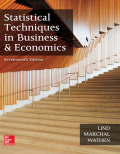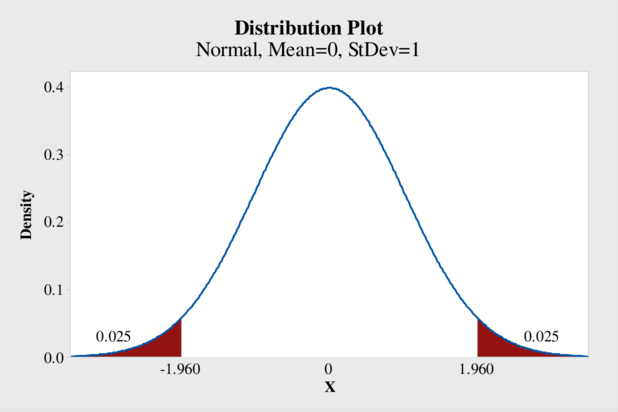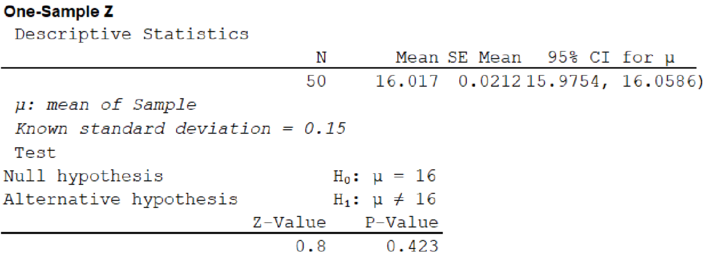
Concept explainers
Heinz, a manufacturer of ketchup, uses a particular machine to dispense 16 ounces of its ketchup into containers. From many years of experience with the particular dispensing machine, Heinz knows the amount of product in each container follows a
- (a) State the null hypothesis and the alternate hypothesis.
- (b) What is the
probability of a Type I error? - (c) Give the formula for the test statistic.
- (d) State the decision rule.
- (e) Determine the value of the test statistic.
- (f) What is your decision regarding the null hypothesis?
- (g) Interpret, in a single sentence, the result of the statistical test.
a.
State the hypotheses.
Answer to Problem 1SR
The null hypothesis is
The alternative hypothesis is
Explanation of Solution
Here, the claim is that there is evidence that the mean amount dispensed is different from 16 ounces. This defines the alternative hypothesis.
Let
The hypotheses are given below:
Null hypothesis:
Alternative hypothesis:
b.
Write the probability of a Type I error
Explanation of Solution
Type I error:
Probability of rejecting
Here, the null hypothesis is rejected. But in actual the mean amount dispensed is 16 ounces.
c.
Write the formula for the test statistic.
Explanation of Solution
The formula for the test statistic is given below:
Where,
d.
Write the decision rule.
Explanation of Solution
Step-by-step procedure to obtain the critical value using MINITAB:
- Choose Graph > Probability Distribution Plot choose View Probability > OK.
- From Distribution, choose ‘Normal’ distribution.
- Click the Shaded Area tab.
- Choose Probability and Both Tail for the region of the curve to shade.
- Enter the Probability value as 0.05.
- Click OK.
Output using the MINITAB software is given below:

From the output, the critical value is ±1.96.
Decision rule:
If
If
e.
Find the value of test statistic.
Answer to Problem 1SR
The value of test statistic is 0.8.
Explanation of Solution
Step by step procedure to obtain the test statistic using MINITAB software is given below:
- Choose Stat > Basic Statistics > 1-Sample Z.
- In Summarized data, enter the sample size as 50 and mean as 16.017.
- In Standard deviation, enter 0.15.
- Check Options, enter Confidence level as 95.
- In Perform Hypothesis test, enter 16 Under Hypothesized mean.
- Choose Mean ≠ Hypothesized mean in alternative.
- Click OK in all dialogue boxes.
Output using the MINITAB software is given below:

From the MINITAB output, the value of test statistic is 0.8.
f.
Find the decision.
Answer to Problem 1SR
The decision is that fail to reject the null hypothesis.
Explanation of Solution
Decision:
Here, the computed z-value is 0.8.
The computed z-value lies between ±1.96.
From the decision rule, fail to reject the null hypothesis.
g.
Write the single sentence for the result of the test.
Explanation of Solution
The null hypothesis is not rejected. Hence, it can be concluded that there is no evidence that the mean amount dispensed is different from 16 ounces.
Want to see more full solutions like this?
Chapter 10 Solutions
EBK STATISTICAL TECHNIQUES IN BUSINESS
- Harvard University California Institute of Technology Massachusetts Institute of Technology Stanford University Princeton University University of Cambridge University of Oxford University of California, Berkeley Imperial College London Yale University University of California, Los Angeles University of Chicago Johns Hopkins University Cornell University ETH Zurich University of Michigan University of Toronto Columbia University University of Pennsylvania Carnegie Mellon University University of Hong Kong University College London University of Washington Duke University Northwestern University University of Tokyo Georgia Institute of Technology Pohang University of Science and Technology University of California, Santa Barbara University of British Columbia University of North Carolina at Chapel Hill University of California, San Diego University of Illinois at Urbana-Champaign National University of Singapore McGill…arrow_forwardName Harvard University California Institute of Technology Massachusetts Institute of Technology Stanford University Princeton University University of Cambridge University of Oxford University of California, Berkeley Imperial College London Yale University University of California, Los Angeles University of Chicago Johns Hopkins University Cornell University ETH Zurich University of Michigan University of Toronto Columbia University University of Pennsylvania Carnegie Mellon University University of Hong Kong University College London University of Washington Duke University Northwestern University University of Tokyo Georgia Institute of Technology Pohang University of Science and Technology University of California, Santa Barbara University of British Columbia University of North Carolina at Chapel Hill University of California, San Diego University of Illinois at Urbana-Champaign National University of Singapore…arrow_forwardA company found that the daily sales revenue of its flagship product follows a normal distribution with a mean of $4500 and a standard deviation of $450. The company defines a "high-sales day" that is, any day with sales exceeding $4800. please provide a step by step on how to get the answers in excel Q: What percentage of days can the company expect to have "high-sales days" or sales greater than $4800? Q: What is the sales revenue threshold for the bottom 10% of days? (please note that 10% refers to the probability/area under bell curve towards the lower tail of bell curve) Provide answers in the yellow cellsarrow_forward
- Find the critical value for a left-tailed test using the F distribution with a 0.025, degrees of freedom in the numerator=12, and degrees of freedom in the denominator = 50. A portion of the table of critical values of the F-distribution is provided. Click the icon to view the partial table of critical values of the F-distribution. What is the critical value? (Round to two decimal places as needed.)arrow_forwardA retail store manager claims that the average daily sales of the store are $1,500. You aim to test whether the actual average daily sales differ significantly from this claimed value. You can provide your answer by inserting a text box and the answer must include: Null hypothesis, Alternative hypothesis, Show answer (output table/summary table), and Conclusion based on the P value. Showing the calculation is a must. If calculation is missing,so please provide a step by step on the answers Numerical answers in the yellow cellsarrow_forwardShow all workarrow_forward
 Glencoe Algebra 1, Student Edition, 9780079039897...AlgebraISBN:9780079039897Author:CarterPublisher:McGraw Hill
Glencoe Algebra 1, Student Edition, 9780079039897...AlgebraISBN:9780079039897Author:CarterPublisher:McGraw Hill Big Ideas Math A Bridge To Success Algebra 1: Stu...AlgebraISBN:9781680331141Author:HOUGHTON MIFFLIN HARCOURTPublisher:Houghton Mifflin Harcourt
Big Ideas Math A Bridge To Success Algebra 1: Stu...AlgebraISBN:9781680331141Author:HOUGHTON MIFFLIN HARCOURTPublisher:Houghton Mifflin Harcourt

